
LAPRYSTA 10 mg/ml SYRUP
Ask a doctor about a prescription for LAPRYSTA 10 mg/ml SYRUP

How to use LAPRYSTA 10 mg/ml SYRUP
Introduction
Package Leaflet: Information for the Patient
Laprysta 10 mg/ml Oral Solution EFG
lacosamide
Read all of this leaflet carefully before you start taking this medicine because it contains important information for you.
- Keep this leaflet, you may need to read it again.
- If you have any further questions, ask your doctor or pharmacist.
- This medicine has been prescribed for you only. Do not pass it on to others. It may harm them, even if their signs of illness are the same as yours.
- If you get any side effects, talk to your doctor or pharmacist. This includes any possible side effects not listed in this leaflet. See section 4.
Contents of the pack
- What Laprysta oral solution is and what it is used for
- What you need to know before you take Laprysta oral solution
- How to take Laprysta oral solution
- Possible side effects
- Storage of Laprysta oral solution
- Contents of the pack and other information
1. What Laprysta oral solution is and what it is used for
What isLaprysta oral solution
Laprysta oral solution contains lacosamide, which belongs to a group of medicines called “antiepileptic medicines”. These medicines are used to treat epilepsy.
- You have been prescribed this medicine to reduce the number of seizures you have.
WhatLaprysta oral solutionis used for
- Laprysta oral solution is used:
- on its own and with other antiepileptics in adults, adolescents and children from 2 years of age to treat a certain type of epilepsy characterized by the occurrence of partial-onset seizures with or without secondary generalization. In this type of epilepsy, the seizures affect only one side of your brain. However, they can then spread to larger areas on both sides of your brain;
- with other antiepileptics in adults, adolescents and children from 4 years of age to treat primary generalized tonic-clonic seizures (major seizures, with loss of consciousness) in patients with idiopathic generalized epilepsy (a type of epilepsy that is believed to have a genetic origin).
2. What you need to know before you take Laprysta oral solution
Do not takeLaprysta oral solution
- if you are allergic to lacosamide or any of the other ingredients of this medicine (listed in section 6). If you are not sure, consult your doctor.
- if you have a heart rhythm problem called second or third degree AV block.
Do not take this medicine if any of the above applies to you. If you are not sure, consult your doctor or pharmacist before taking this medicine.
Warnings and precautions
Consult your doctor before starting to use Laprysta oral solution if:
- you have thoughts of self-harm or suicide. A small number of people taking antiepileptics such as lacosamide have had thoughts of self-harm or suicide. If you have such thoughts at any time, contact your doctor immediately.
- you have a heart problem that affects your heartbeat and your pulse is often especially slow, fast or irregular (such as an AV block, atrial fibrillation or atrial flutter)
- you have severe heart disease such as heart failure or have had a heart attack.
- You often feel dizzy or faint. This medicine may cause dizziness, which could increase the risk of accidental injury or falls. This means you should be careful until you are used to the effects of this medicine.
If any of the above applies to you (or you are not sure), consult your doctor or pharmacist before taking this medicine.
If you are taking lacosamide and experience symptoms of abnormal heartbeat (such as slow, fast or irregular heartbeat, palpitations, shortness of breath, feeling of dizziness, fainting), consult your doctor immediately (see section 4).
Children
This medicine is not recommended for children under 2 years of age with epilepsy characterized by the occurrence of partial-onset seizures and is not recommended for children under 4 years of age with primary generalized tonic-clonic seizures. This is because it is not yet known if it is effective and safe for children in this age group.
Other medicines and Laprysta oral solution
Tell your doctor or pharmacist if you are taking, have recently taken or might take any other medicines.
In particular, tell your doctor or pharmacist if you are taking any of the following medicines that affect the heart, as lacosamide may also affect the heart:
- medicines for heart problems;
- medicines that may increase the “PR interval” in a heart test (ECG or electrocardiogram) such as epilepsy or pain medicines called carbamazepine, lamotrigine or pregabalin;
- medicines used to treat certain types of arrhythmia or heart failure.
If any of the above applies to you (or you are not sure), talk to your doctor or pharmacist before taking this medicine.
Tell your doctor or pharmacist if you are taking any of the following medicines, as they may also increase or decrease the effect of lacosamide in your body:
- medicines for fungal infections such as fluconazole, itraconazole or ketoconazole;
- HIV medicines such as ritonavir;
- medicines for bacterial infections such as clarithromycin or rifampicin;
- a herbal medicine used to treat mild anxiety and depression called St. John's Wort.
If any of the above applies to you (or you are not sure) talk to your doctor or pharmacist before taking this medicine.
TakingLaprysta oral solutionwith alcohol
As a precaution, do not take this medicine with alcohol.
Pregnancy and breast-feeding
If you are pregnant or breast-feeding, think you may be pregnant or are planning to have a baby, ask your doctor or pharmacist for advice before taking this medicine.
Lacosamide is not recommended during pregnancy or breast-feeding, as its effects on pregnancy and the fetus or newborn are not known. Additionally, it is not known if this medicine passes into breast milk. Ask your doctor for advice immediately if you are pregnant or planning to become pregnant. Your doctor will help you decide whether to take this medicine or not.
Do not stop treatment without talking to your doctor first, as this may increase the risk of seizures (fits). Worsening of your condition may also harm the fetus.
Driving and using machines
Do not drive, ride a bicycle or use any tools or machines until you know if this medicine affects you. The reason is that this medicine may cause dizziness or blurred vision.
Laprysta oral solution contains sorbitol (E 420), propylene glycol (E 1520), sodium, methyl parahydroxybenzoate (E 219), aspartame (E 951) and potassium.
- Sorbitol (E 420): this medicine contains 280 mg of sorbitol in each ml.
Sorbitol is a source of fructose. If your doctor has told you (or your child) that you have an intolerance to some sugars, or if you (or your child) have been diagnosed with hereditary fructose intolerance (HFI), a rare genetic disorder in which the patient cannot break down fructose, consult your doctor before taking this medicine. Sorbitol may cause gastrointestinal upset and a mild laxative effect.
- Propylene glycol (E 1520): this medicine contains 40.5 mg of propylene glycol in each ml.
- Sodium: this medicine contains 4.64 mg of sodium (a major component of table/cooking salt) in each ml. This is equivalent to 0.2% of the maximum recommended daily intake of sodium for an adult.
- Methyl parahydroxybenzoate (E 219): may cause allergic reactions (possibly delayed).
- Aspartame (E 951): this medicine contains 0.4 mg of aspartame in each ml. Aspartame is a source of phenylalanine that may be harmful if you have phenylketonuria (PKU), a rare genetic disorder in which phenylalanine accumulates because the body cannot eliminate it properly.
- Potassium: this medicine contains potassium, less than 1 mmol (39 mg) per 60 ml, which is essentially “potassium-free”.
3. How to take Laprysta syrup
Follow the administration instructions for this medication exactly as indicated by your doctor or pharmacist. If in doubt, consult your doctor or pharmacist again.
Taking Laprysta syrup
- Take this medication twice a day, with an interval of approximately 12 hours.
- Try to take it more or less at the same time every day.
- You can take this medication with or without food.
Normally, you will start taking a low dose every day and your doctor will gradually increase the dose over several weeks. When you reach the dose that works well for you, called the "maintenance dose," you will take the same amount every day. When the recommended dose cannot be achieved with the dosing device in a single administration, the required dose must be achieved with multiple administrations (e.g., for a dose of 300 ml (30 ml) with a 25 ml dosing cup: one 25 ml cup + one 5 ml cup.
Laprysta syrup is used as long-term treatment. You will need to continue taking this medication until your doctor tells you to stop.
How much to take
The following are the normal recommended doses of lacosamide for different age groups and weights.
Your doctor may prescribe a different dose if you have kidney or liver problems.
Use the 10 ml oral syringe or the 25 ml measuring cup provided in the outer box, as appropriate, according to the necessary dose. See the instructions for use below.
Adolescents and children who weigh 50 kg or more and adults
- Use the measuring cup included in the box.
When taking Laprysta syrup alone:
The usual starting dose is 50 mg (5 ml), twice a day.
Your doctor may prescribe a starting dose of 100 mg (10 ml) of this medication twice a day.
Your doctor may increase the dose you take twice a day by 50 mg (5 ml) each week, until you reach a maintenance dose between 100 mg (10 ml) and 300 mg (30 ml) twice a day.
When taking Laprysta syrup with other antiepileptic medications
The usual starting dose is 50 mg (5 ml) twice a day.
Your doctor may increase the dose you take twice a day by 50 mg (5 ml) each week, until you reach a maintenance dose between 100 mg (10 ml) and 200 mg (20 ml) twice a day.
If you weigh 50 kg or more, your doctor may decide to start lacosamide treatment with a single "loading" dose of 200 mg (20 ml). Then you will start taking the continuous maintenance dose 12 hours later.
Children and adolescents who weigh less than 50 kg
- In the treatment of partial onset seizures: note that this medication is not recommended for children under 2 years of age.
- In the treatment of primary generalized tonic-clonic seizures: note that this medication is not recommended for children under 4 years of age.
When taking Laprysta syrup alone
- Your doctor will decide the dose of lacosamide according to your body weight.
- The usual starting dose is 1 mg (0.1 ml) per kilogram (kg) of body weight, twice a day.
- Your doctor may increase the dose you take twice a day by 1 mg (0.1 ml) per kilogram of body weight, each week, until you reach the maintenance dose.
- The following are the dosing tables with the maximum recommended dose.
- These doses are for informational purposes only. Your doctor will calculate the correct dose for you.
To be taken twice a day,for children from 2 years of age who weighfrom 10 to less than 40kg
Weight | Week 1 Initial Dose: 0.1 ml/kg | Week 2 0.2 ml/kg | Week 3 0.3 ml/kg | Week 4 0.4 ml/kg | Week 5 0.5 ml/kg | Week 6 Maximum Recommended Dose: 0.6 ml/kg |
Use of the 10 ml syringe (black graduation marks) for a volume between 1 ml and 20 ml * Use of the 25 ml measuring cup (black graduation marks) for a volume of more than 20 ml | ||||||
10 kg | 1 ml | 2 ml | 3 ml | 4 ml | 5 ml | 6 ml |
15 kg | 1.5 ml | 3 ml | 4.5 ml | 6 ml | 7.5 ml | 9 ml |
20 kg | 2 ml | 4 ml | 6 ml | 8 ml | 10 ml | 12 ml |
25 kg | 2.5 ml | 5 ml | 7.5 ml | 10 ml | 12.5 ml | 15 ml |
30 kg | 3 ml | 6 ml | 9 ml | 12 ml | 15 ml | 18 ml |
35 kg | 3.5 ml | 7 ml | 10.5 ml | 14 ml | 17.5 ml | 21 ml* |
To be taken twice a day,for children and adolescents who weigh from 40 kg to less than 50 kg
Weight | Week 1 Initial Dose: 0.1 ml/kg | Week 2 0.2 ml/kg | Week 3 0.3 ml/kg | Week 4 0.4 ml/kg | Week 5 Maximum Recommended Dose: 0.5 ml/kg |
Use of the 10 ml syringe for a volume between 1 ml and 20 ml
| |||||
40 kg | 4 ml | 8 ml | 12 ml | 16 ml | 20 ml |
45 kg | 4.5 ml | 9 ml | 13.5 ml | 18 ml | 22.5 ml* |
When taking Laprysta syrup with other antiepileptic medications
- Your doctor will decide the dose of lacosamide according to your body weight.
- The usual starting dose is 1 mg (0.1 ml) per kilogram (kg) of body weight, twice a day.
- The following are the dosing tables with the maximum recommended dose.
- These doses are for informational purposes only. Your doctor will calculate the correct dose for you.
To be taken twice a day,for children from 2 years of age who weigh from 10 kg to less than 20 kg
Week | Week 1 Initial Dose: 0.1 ml/kg | Week 2 0.2 ml/kg | Week 3 0.3 ml/kg | Week 4 0.4 ml/kg | Week 5 0.5 ml/kg | Week 6 Maximum Recommended Dose: 0.6 ml/kg |
Use of the 10 ml syringe (black graduation marks) for a volume between 1 ml and 20 ml | ||||||
10 kg | 1 ml | 2 ml | 3 ml | 4 ml | 5 ml | 6 ml |
12 kg | 1.2 ml | 2.4 ml | 3.6 ml | 4.8 ml | 6 ml | 7.2 ml |
14 kg | 1.4 ml | 2.8 ml | 4.2 ml | 5.6 ml | 7 ml | 8.4 ml |
15 kg | 1.5 ml | 3 ml | 4.5 ml | 6 ml | 7.5 ml | 9 ml |
16 kg | 1.6 ml | 3.2 ml | 4.8 ml | 6.4 ml | 8 ml | 9.6 ml |
18 kg | 1.8 ml | 3.6 ml | 5.4 ml | 7.2 ml | 9 ml | 10.8 ml |
To be taken twice a day,for adolescents and children who weigh from 20 kg to less than 30 kg:
Weight | Week 1 Initial Dose: 0.1 ml/kg | Week 2 0.2 ml/kg | Week 3 0.3 ml/kg | Week 4 0.4 ml/kg | Week 5 Maximum Recommended Dose: 0.5 ml/kg |
Use of the 10 ml syringe (black graduation marks) for a volume between 1 ml and 20 ml | |||||
20 kg | 2 ml | 4 ml | 6 ml | 8 ml | 10 ml |
22 kg | 2.2 ml | 4.4 ml | 6.6 ml | 8.8 ml | 11 ml |
24 kg | 2.4 ml | 4.8 ml | 7.2 ml | 9.6 ml | 12 ml |
25 kg | 2.5 ml | 5 ml | 7.5 ml | 10 ml | 12.5 ml |
26 kg | 2.6 ml | 5.2 ml | 7.8 ml | 10.4 ml | 13 ml |
28 kg | 2.8 ml | 5.6 ml | 8.4 ml | 11.2 ml | 14 ml |
To be taken twice a day,for adolescents and children who weigh from 30 kg to less than 50 kg:
Weight | Week 1 Initial Dose: 0.1 ml/kg | Week 2 0.2 ml/kg | Week 3 0.3 ml/kg | Week 4 Maximum Recommended Dose: 0.4 ml/kg |
Use of the 10 ml syringe (black graduation marks) for a volume between 1 ml and 20 ml | ||||
30 kg | 3 ml | 6 ml | 9 ml | 12 ml |
35 kg | 3.5 ml | 7 ml | 10.5 ml | 14 ml |
40 kg | 4 ml | 8 ml | 12 ml | 16 ml |
45 kg | 4.5 ml | 9 ml | 13.5 ml | 18 ml |
Instructions for use
It is essential that you use the correct device to measure your dose. Your doctor or pharmacist will indicate which device you should use based on the dose prescribed for you.
10 ml oral syringe | 25 ml measuring cup |
The 10 ml oral syringe has graduations in increments of 0.25 ml. If the necessary dose is between 1 ml and 10 ml, you should use the 10 ml oral syringe and the adapter provided in this package. If the necessary dose is between 10 ml and 20 ml, you should use the 10 ml syringe twice. | The 25 ml measuring cup has graduations in increments of 5 ml. If the necessary dose is more than 20 ml, you should use the 25 ml measuring cup included in this package. |
Instructions for use: measuring cup
- Shake the bottle well before use.
- Fill the measuring cup to the graduation mark of the milliliters (ml) prescribed by your doctor.
- Swallow the dose of syrup.
- Then drink a little water.
Instructions for use: oral syringe
Your doctor will show you how to use the oral syringe before you use it for the first time. If you have any questions, consult your doctor or pharmacist.
Children andadolescentswho weigh less than 50kg
- Use the oral syringe and the adapter included in this package.
Shake the bottle well before using it.
Open the bottle by pressing the cap while turning it counterclockwise (figure 1).
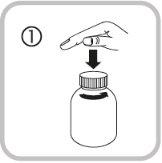
Follow these steps the first time you take Laprysta syrup:
- Remove the adapter from the oral syringe (figure 2).
- Place the adapter on the top of the bottle (figure 3). Make sure it is well fixed. You do not need to remove the adapter after use.
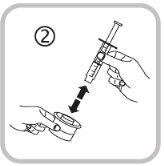
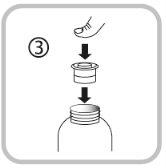
Follow these steps each time you take this medication:
- Place the oral syringe in the adapter opening (figure 4).
- Place the bottle upside down (figure 5).
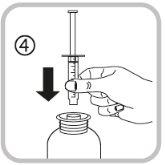

- Hold the bottle upside down with one hand and use the other to fill the oral syringe.
- Pull the plunger down to fill the oral syringe with a small amount of solution (figure 6).
- Press the plunger up to eliminate any possible bubbles (figure 7).
- Pull the plunger down to the dose mark that corresponds to the milliliters (ml) prescribed by your doctor (figure 8).
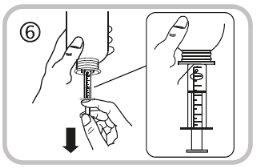

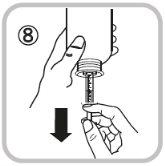
- Turn the bottle to the correct position (figure 9).
- Remove the oral syringe from the adapter (figure 10).
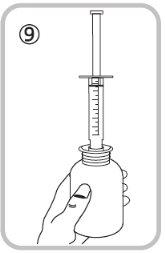
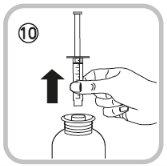
There are two ways you can choose to take the medication:
- Empty the contents of the oral syringe into a little water by pressing the plunger to the bottom of the oral syringe (figure 11) - in which case you will need to drink all the water (add just enough water to make it easier to drink) or
- Take the solution directly from the oral syringe without water (figure 12) - drink all the contents of the oral syringe.
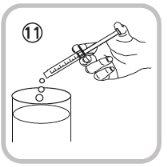
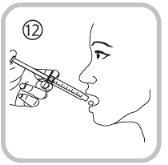
- Close the bottle with the plastic screw cap (you do not need to remove the adapter).
- Wash the oral syringe only with water (figure 13).

If you take more Laprysta syrup than you should
If you have taken more lacosamide than you should, consult your doctor immediately. Do not try to drive.
You may experience:
- Dizziness.
- Feeling nauseous (nausea) or being nauseous (vomiting).
- Seizures (convulsions), heart rhythm problems such as slow, fast, or irregular pulse, coma, or low blood pressure with tachycardia and sweating.
In case of overdose or accidental ingestion, consult your doctor or pharmacist immediately or call the Toxicology Information Service, phone 91 562 04 20, indicating the medication and the amount ingested.
If you forget to take Laprysta syrup
- If you have forgotten to take a dose within the next 6 hours after the scheduled dose, take it as soon as you remember.
- If you have forgotten to take a dose after 6 hours after the scheduled dose, do not take the missed dose. Instead, take lacosamide the next time you would normally take it.
- Do not take a double dose to make up for missed doses.
If you stop treatment with Laprysta syrup
- Do not stop taking this medication without telling your doctor, as epilepsy may appear again or worsen.
- If your doctor decides to stop your treatment with this medication, they will give you instructions on how to gradually decrease the dose.
If you have any other questions about the use of this product, ask your doctor or pharmacist.
4. Possible Adverse Effects
Like all medicines, this medicine may cause adverse effects, although not all people suffer from them.
Adverse effects on the nervous system, such as dizziness, may be greater after a single "loading" dose.
Tell your doctor or pharmacist if you experience any of the following effects:
Very common: may affect more than 1 in 10 patients
- Headache;
- Feeling dizzy or sick (nausea);
- Double vision (diplopia).
Common: may affect up to 1 in 10 patients
- Difficulty maintaining balance, agitation (tremor), tingling (paresthesia) or muscle spasms, easy falling and bruising;
- Memory problems, difficulty thinking or finding words, confusion;
- Rapid, uncontrolled eye movements (nystagmus);
- Blurred vision;
- Feeling of dizziness (vertigo), feeling of intoxication;
- Being dizzy (vomiting), dry mouth, constipation, indigestion, excessive gas in the stomach or intestine, diarrhea;
- Decreased sensitivity, difficulty articulating words, attention disorder;
- Noise in the ears like buzzing, ringing or whistling;
- Irritability, sleep problems, depression;
- Somnolence, fatigue or weakness (asthenia);
- Itching, rash.
Uncommon: may affect up to 1 in 100 patients
- Decreased heart rate, palpitations, irregular pulse or other changes in heart electrical activity (conduction disorder);
- Exaggerated feeling of well-being, seeing and/or hearing things that are not real;
- Allergic reaction to taking the medicine, hives;
- Blood tests may show liver function abnormalities, liver damage;
- Thoughts of self-harm or suicide or attempted suicide: inform your doctor immediately;
- Feeling angry or agitated Abnormal thoughts and/or loss of sense of reality;
- Severe allergic reactions, which cause swelling of the face, throat, hands, feet, ankles or lower legs;
- Fainting,
- Difficulty coordinating movements or walking
Frequency not known: cannot be estimated from the available data
- Abnormally fast heartbeat (ventricular tachyarrhythmia);
- Sore throat, elevated temperature and frequent infections. Blood tests may show a severe decrease in a specific class of white blood cells (agranulocytosis);
- Severe skin reaction, which may include elevated temperature and other flu-like symptoms, rash on the face, generalized rash with lymph node inflammation (enlarged lymph nodes). Blood tests may show an increase in liver enzyme levels and an increase in a type of white blood cell (eosinophilia);
- A generalized rash with blisters and skin peeling, especially around the mouth, nose, eyes, and genitals (Stevens-Johnson syndrome) and a more severe form that causes skin peeling on more than 30% of the body surface (toxic epidermal necrolysis).
- Seizures.
Other adverse effects in children
Additional adverse effects observed in children were fever (pyrexia), runny nose (nasopharyngitis), sore throat (pharyngitis), eating less than usual (decreased appetite), behavioral changes, not acting as they normally do (abnormal behavior) and lack of energy (lethargy). Sleepiness (somnolence) is a very common side effect in children and may affect more than 1 in 10 children .
Reporting of adverse effects
If you experience any type of adverse effect, consult your doctor or pharmacist, even if it is a possible adverse effect that is not listed in this leaflet. You can also report them directly through the Spanish Pharmacovigilance System for Human Use Medicines: www.notificaram.es.
By reporting adverse effects, you can contribute to providing more information on the safety of this medicine.
5. Storage of Laprysta syrup
Keep this medicine out of the sight and reach of children.
Do not use this medicine after the expiration date that appears on the box and on the bottle, after CAD/EXP. The expiration date is the last day of the month indicated.
Do not refrigerate.
Once the syrup bottle is opened, do not use it after 2 months.
Medicines should not be thrown away through wastewater or household waste. Deposit the packaging and medicines you no longer need at the SIGRE Point in the pharmacy. Ask your pharmacist how to dispose of the packaging and medicines you no longer need. This way, you will help protect the environment.
6. Package contents and additional information
Composition ofLaprysta syrup
- The active ingredient is lacosamide. 1 ml of this medicine contains 10 mg of lacosamide.
- The other ingredients are: liquid sorbitol 70% (non-crystallizable) (E 420), glycerol, propylene glycol (E 1520), macrogol 4000, sodium chloride, sodium carmellose, acesulfame potassium (E950), anhydrous citric acid, methylparaben sodium (E219), strawberry flavor (contains propylene glycol (E 1520)), aspartame (E951) and purified water.
Appearance of the product and package contents
- Laprysta 10 mg/ml syrup is a clear, colorless and slightly viscous liquid.
- This medicine is available in a 200 ml bottle.
The box of Laprysta syrup includes a 25 ml measuring cup with graduated marks and a 10 ml oral syringe.
- The measuring cup is suitable for doses over 20 ml.
The measuring cup shows three different non-linear scales on three different sides, to allow for precise graduation of different doses. Each graduation mark is accompanied by the mention of the corresponding volume in ml. The minimum extractable volume is 2 ml, which is 20 mg of lacosamide. The maximum extractable volume is 25 ml, which is 250 mg of lacosamide.
- The 10 ml oral syringe is suitable for doses between 1 ml and 20 ml. A 10 ml oral syringe filled corresponds to 100 mg of lacosamide. The minimum extractable volume is 1 ml, which corresponds to 10 mg of lacosamide. After this, each graduation mark (0.25 ml) corresponds to 2.5 mg of lacosamide (for example, 4 graduation marks correspond to 10 mg).
Marketing authorization holder and manufacturer
Marketing authorization holder
Neuraxpharm Spain, S.L.U.
Avda. Barcelona 69,
08970 Sant Joan Despí – Barcelona
Spain
Manufacturer
neuraxpharm Arzneimittel GmbH
Elisabeth-Selbert-Strasse 23
40764 Langenfeld
Germany
This medicine is authorized in the EEA member states with the following names:
Italy: Laprysta
Spain: Laprysta 10 mg/ml syrup EFG
Date of the last revision of this leaflet: July 2023
Other sources of information
Detailed information about this medicine is available on the website of the Spanish Agency for Medicines and Health Products (AEMPS) http://www.aemps.gob.es/.

How much does LAPRYSTA 10 mg/ml SYRUP cost in Spain ( 2025)?
The average price of LAPRYSTA 10 mg/ml SYRUP in December, 2025 is around 23.49 EUR. Prices may vary depending on the region, pharmacy, and whether a prescription is required. Always check with a local pharmacy or online source for the most accurate information.
- Country of registration
- Average pharmacy price23.49 EUR
- Active substance
- Prescription requiredYes
- Manufacturer
- This information is for reference only and does not constitute medical advice. Always consult a licensed doctor before taking any medication. Oladoctor is not responsible for medical decisions based on this content.
- Alternatives to LAPRYSTA 10 mg/ml SYRUPDosage form: TABLET, 100 mgActive substance: lacosamideManufacturer: Intas Third Party Sales 2005 S.L.Prescription requiredDosage form: TABLET, 150 mgActive substance: lacosamideManufacturer: Intas Third Party Sales 2005 S.L.Prescription requiredDosage form: TABLET, 200 mgActive substance: lacosamideManufacturer: Intas Third Party Sales 2005 S.L.Prescription required
Alternatives to LAPRYSTA 10 mg/ml SYRUP in other countries
The best alternatives with the same active ingredient and therapeutic effect.
Alternative to LAPRYSTA 10 mg/ml SYRUP in Polska
Alternative to LAPRYSTA 10 mg/ml SYRUP in Ukraina
Online doctors for LAPRYSTA 10 mg/ml SYRUP
Discuss dosage, side effects, interactions, contraindications, and prescription renewal for LAPRYSTA 10 mg/ml SYRUP – subject to medical assessment and local rules.







